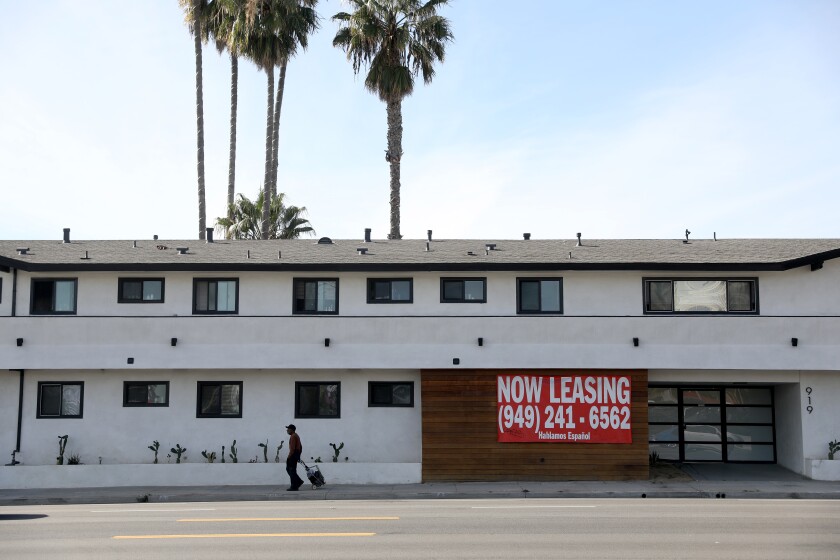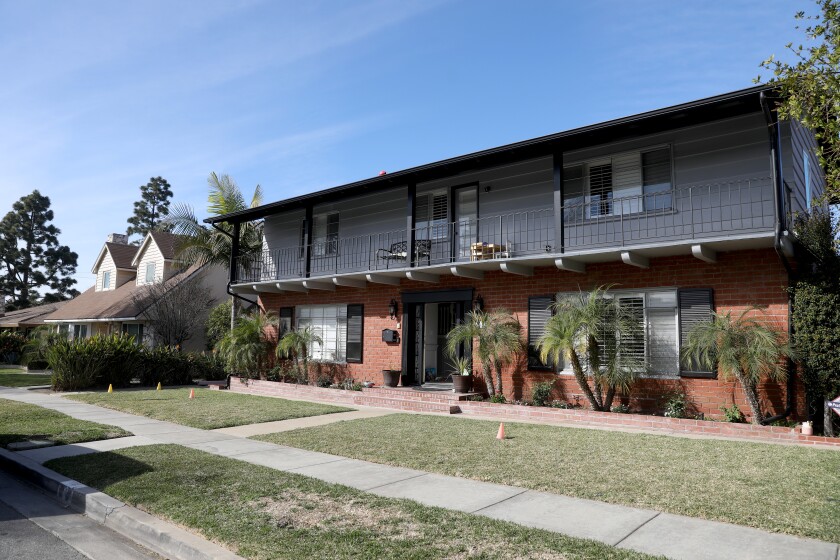‘A crisis for renters’: Football sent Inglewood home prices and rents skyrocketing
Inglewood’s home and rent prices have skyrocketed since the NFL approved plans for the Rams to relocate to Inglewood in 2016, outpacing surrounding communities and Los Angeles County.
The price increases, which also have been propelled by recent development beyond SoFi Stadium in the city of nearly 108,000 residents, is a boon for home sellers, developers and landlords. But more expensive houses and apartments mean Inglewood is less affordable, pricing out longtime Black and Latino residents.
“This is a crisis for renters. Even though rent-control ordinances have been put in place, landlords still have several other ways to raise rent,” said Rick Foard, an organizer with the Lennox-Inglewood Tenants Union, an activist organization that advocates for renters’ rights in the city. Roughly two-thirds of Inglewood residents are renters, according to census data.
In 2016, Inglewood was one of the most affordable places to buy a home in Los Angeles County. Out of 159 communities in the county where real estate firm Zillow tracks prices, Inglewood and its median home sale price of $402,271 ranked 124th.
As of last year, it had leapfrogged 27 neighborhoods to the 97th spot with a median price of $739,254 — an increase of nearly 84%.
The price increases have been consistent, rising at least $25,000 every year since 2016. The biggest leap occurred from 2020 to 2021, the same year the stadium opened. During that stretch, when the pandemic created a historically hot housing market due to low interest rates and ultra-high demand, the median home price jumped $76,933 — about 13% year over year.
Rents have surged too. In January 2016, an average one-bedroom apartment in Inglewood rented for $1,100, according to Zumper, an apartment rental listing website. Today, the average is $1,750, an increase of $650.
That’s roughly double the increase in L.A., where rents rose $335 during the same stretch.
Inglewood addressed fast-rising rents in 2019, expanding eviction protections and limiting rent hikes to 3% a year for buildings with five or more units constructed before February 1995.
But a landlord can get a bigger increase if inflation runs above 3%, by making improvements or petitioning the city — both within strict limits. If a tenant moves out, the landlord can increase the rent to market rates but then must abide by the 3% annual increase rule. Newer buildings aren’t covered by Inglewood’s rent-control ordinance.
There’s no reason to expect that prices won’t keep jumping for homes and newer apartments not covered by rent control. Super Bowl LVI is SoFi Stadium’s biggest coming-out party so far — a fitting end to the first football season during which fans were allowed inside — but SoFi will rise to bigger stages, both nationally and globally, in the coming years.
In 2023, the stadium is set to host the College Football Playoff National Championship, as well as WrestleMania 39. SoFi is also bidding to host the World Cup final in 2026. In 2028, it will be the site of the Olympic opening and closing ceremonies.
Joining the party soon are the Los Angeles Clippers, who are in the process of erecting an 18,000-seat arena just south of SoFi called Intuit Dome.
Residents are afraid the new stadiums and other development will make Inglewood too expensive to live in and will increase gentrification.
“The Super Bowl, aside from its role in society of taking people’s minds off of real problems, is not particularly helpful, economically or culturally, for people who live in the neighborhood, which has quite a few low-income folks,” tenant organizer Foard said.
“The rise in both rent and home prices started as soon as it was announced that SoFi Stadium would be built,” said Foard, a retired legal services attorney.
The history of Stadium View Apartments, directly across the street from SoFi Stadium, illustrates the tensions at play.
Built in 1959, the 50-unit complex was called Inglewood Gardens before there was any stadium to view. In 2018, rents increased 33%, tenant advocates said.
Alfa Investments bought the building in 2019 for $10.3 million and since has spent $1.5 million on renovations, said Bryan Russo, a partner in the firm, which owns several apartment buildings in Southern California.

Stadium View Apartments, a complex across the street from SoFi Stadium, was recently renovated. The stadium and other development have led to higher housing prices in Inglewood.
(Gary Coronado / Los Angeles Times)
In addition to the new name, the owners refreshed the exterior and made other repairs, including new plumbing, windows, doors and locks as well as a new security gate and cameras, Russo said.
But the Lennox-Inglewood Tenants Union contends there are are still more repairs to be done and have protested outside the complex alongside current tenants. The group claims Alfa Investment isn’t making repairs because it wants tenants to move out, which would allow the landlord to raise rent significantly.
Russo denied the accusation, saying: “That’s not what I’m looking to do.” All repairs required by the city have been made, he said.
“We don’t have obligation to replace a torn-up carpet because the owner has a dog that ripped up carpet. It’s nuanced and not as simple as they portray it,” Russo said, adding that only a few tenants are unhappy and most “have no issues whatsoever.”
“We only have to provide a habitable residence. There are gray areas, like where they say there’s a hole in wall. Well, who made a hole in the wall?” he said.
South L.A. real estate agent Heather Presha said that when she started selling homes in 2007, she couldn’t get any of her clients to move to Inglewood. People looking in South L.A. were usually aiming for Crenshaw, Baldwin Hills or Leimert Park.
But in the last seven years, Presha has seen only home price increases in Inglewood as demand has boomed.
Per usual in areas with new development, most people selling their homes in Inglewood are older — Presha estimates around 80% — while most buyers are millennials.

This home in Inglewood was sold for $1.35 million last year. The Colonial-style spot about a mile from SoFi Stadium last sold in 2012 — before the stadium was announced — for $424,900.
(Gary Coronado / Los Angeles Times)
The demand has created a luxury market in Inglewood that previously didn’t exist. Before 2020, only one Inglewood home had ever sold for more than $1 million. Since then, 18 homes have traded hands for $1 million or more.
According to the Multiple Listing Service, the priciest home sale in Inglewood history happened in September when a Colonial-style spot about a mile from SoFi Stadium sold for $1.351 million. It last sold in 2012 — before the stadium was announced — for $424,900.
“We had 10 offers on the house, and the counter-offers eventually required them to remove the appraisal contingency,” said Tisha Greene of LA Vision Properties, who listed the home and sold it for about $150,000 over the asking price. The 1950s residence now boasts an upgraded floor plan with French doors, plantation shutters, stained glass windows and a marble entry.
She said the stadium and the influx of new businesses are a huge part of the sales pitch, and the proximity to SoFi was a selling point for the eventual buyer.
Inglewood listings on real estate databases such as Zillow and Redfin often pitch themselves as a potential investment, noting that the buyer could turn the property into an Airbnb rental. Many mention how close they are to SoFi; a few even include a photo of the stadium alongside pictures of the house.
Greene said the trend in Inglewood going forward will be master-planned communities with homes that are larger and nicer than the city’s typical housing stock. Squeezing bigger houses onto smaller lots. More luxury housing, less affordable housing.
“These investors and developers aren’t running a nonprofit,” she said.
